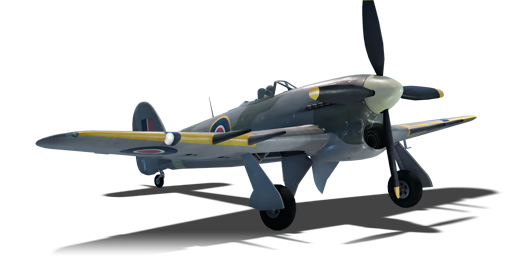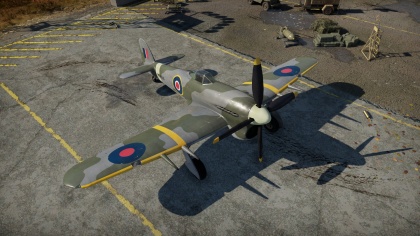Typhoon Mk Ib/L
Contents
| This page is about the aircraft Typhoon Mk Ib/L. For other uses, see Typhoon (Disambiguation) |
Description
The Typhoon Mk Ib /Late is a Rank III British fighter
with a battle rating of 4.7 (AB), 4.3 (RB), and 5.0 (SB). This aircraft has been in the game since the start of the Open Beta Test prior to Update 1.29.
The Typhoon is a heavily armed, fast fighter bomber which excels in Boom and Zoom tactics. It is armed with four deadly Hispano cannons, which can obliterate enemy fighters with the air targets belt. With all module purchased, the Typhoon is one of the fastest planes in its tier, reaching speeds of almost 700km/h in level flight. You also have an excellent climb rate and great maneuverability, enabling you to dogfight quite effectively against some targets.
You also get some decent payload options. A choice of 2x 250, 500 or 1000lb bombs or 8x RP-3 rockets allow you to hit enemy ground targets hard and fast. Just beware that carrying such payloads will adversely effect your flight characteristics. In ground forces RB, it is best to assess the situation on the battlefield. If the enemy team is ground forces heavy, you can chose to thin them out with bombs or rockets. You can even use your cannons to good effect on light targets like the Wirbelwind and PT-76. If the enemy team has a high volume of aircraft in the air, leave the payload and just focus on taking them out.
General info
Flight Performance
| Characteristics | |||||||
|---|---|---|---|---|---|---|---|
| Stock | |||||||
| Max Speed (km/h at 6,248 m) |
Max altitude (meters) |
Turn time (seconds) |
Rate of climb (meters/second) |
Take-off run (meters) | |||
| AB | RB | AB | RB | AB | RB | ||
| 642 | 626 | 11000 | 20.7 | 21.0 | 16.5 | 16.5 | 450 |
| Upgraded | |||||||
| Max Speed (km/h at 6,248 m) |
Max altitude (meters) | Turn time (seconds) | Rate of climb (meters/second) |
Take-off run (meters) | |||
| AB | RB | AB | RB | AB | RB | ||
| 696 | 671 | 11000 | 18.5 | 19.5 | 26.6 | 19.5 | 450 |
Details
| Features | ||||
|---|---|---|---|---|
| Combat flap | Take-off flap | Landing flap | Air brakes | Arrestor gear |
| ✓ | ✓ | ✓ | X | X |
| Limits | ||||
|---|---|---|---|---|
| Wing-break speed (km/h) |
Gear limit (km/h) |
Combat flap (km/h) |
Max Static G | |
| + | - | |||
| 845 | 320 | 420 | ~12 | ~6 |
| Optimal velocities | |||
|---|---|---|---|
| Ailerons (km/h) |
Rudder (km/h) |
Elevators (km/h) |
Radiator (km/h) |
| < 400 | < 440 | < 480 | > 350 |
| Compressor (RB/SB) | ||
|---|---|---|
| Setting 1 | ||
| Optimal altitude | 100% Engine power | WEP Engine power |
| 1,447 m | 2,065 hp | 2,272 hp |
| Setting 2 | ||
| Optimal altitude | 100% Engine power | WEP Engine power |
| 4,981 m | 1,735 hp | 1,909 hp |
Survivability and armour
- 42.8 mm Bulletproof glass in cockpit front.
- 12.7 mm Steel plate behind the pilot.
- 3 mm Steel plate in front of engine.
- 1 mm Steel plate behind the engine.
- Critical components located at the front of aircraft (fuel, pilot, engine, controls)
- More fuel tanks located in wings near the fuselage
Armaments
Offensive armament
The Typhoon Mk Ib/L is armed with:
- 4 x 20 mm Hispano Mk.II cannon, wing-mounted (140 rpg = 560 total)
Suspended armament
The Typhoon Mk Ib/L can be outfitted with the following ordinance:
- Without load
- 2 x G.P. 250 lb Mk.IV bombs
- 2 x G.P. 500 lb Mk.IV bombs
- 2 x M.C. 1000 lb Mk.I bombs
- 8 x 76 mm RP-3 rockets
Usage in the battles
Manual Engine Control
| MEC elements | ||||||
|---|---|---|---|---|---|---|
| Mixer | Pitch | Radiator | Supercharger | Turbocharger | ||
| Oil | Water | Type | ||||
| Not controllable | Controllable | Not controllable | Controllable | Combined | Controllable | Not controllable |
Modules
| Tier | Flight performance | Survivability | Weaponry | ||
|---|---|---|---|---|---|
| I | Fuselage Repair | Radiator | |||
| II | Compressor | Airframe | |||
| III | Wings Repair | Engine | |||
| IV | Engine Injection | Cover | |||
Pros and cons
Pros:
- With combat flaps turn circle is much tighter (arcade battle)
- 4 x high damage Hispano cannons
- Great Boom & Zoom aircraft
- Retains energy well
- Has four optional suspended ordinances (three variety of bombs and HVAR missiles)
Cons:
- Terrible roll rate
- Cannon recoil can cause aircraft to lose speed and easily overheats when stock
- Plane controls start to lock when the speed is over 537 km/h
- Increased parasitic drag when carrying 2 x 1000 lb bombs
- Plane when stock can be difficult to play
History
The Hawker Typhoon was the planned successor to the Hurricane, as a support high altitude fighter for the Spitfire. However early problems with it's structural integrity cause it to commonly break its back on landing. The engine was also far from perfect. The Napier Sabre was very temperamental and always combusted in to flames when started. The large prop was also an issue. The diameter was one of the biggest of the war and a prop strike would almost always flip the aircraft. Another problem was the thick wings the Typhoon used. They had a poor performance at it's intended high altitude and was quickly moved to a low altitude ground attack role. Here it found it's element. The Typhoon's thick wings allowed it to carry 4 20mm cannons and up to a 2000lb bomb load. The "Tiffie" became one of the best RAF ground attack aircraft of the war and was praised for it's stable gun platform and durability. The Typhoon was succeeded by the Tempest, which improved and fixed the earlier design.
The Hawker Typhoon was a single engine, single seat fighter which first entered service with the RAF in 1941. Typhoon fighters of the first production series were equipped with a canopy with massive framing and a Rover-produced car-type side door for cockpit access. The first modification of this was to replace some of the solid metal fairings with transparent panels and cut down the pilot’s head armor plate to help increase visibility. Lack of visibility remained a significant problem and whilst a new canopy was being developed, the bulky radio mast and its fairing were replaced with a whip aerial further aft along the fuselage. A new drop-shaped canopy was designed for the pilot's cockpit, providing a good all-round view. The new canopies were fitted on the production aircraft from September 1943 on.
The fighters were equipped with more powerful 2,200 hp Napier Sabre Mk.IIB and 2,260 hp Napier Sabre Mk.IIC engines, as well as new four-bladed de Havilland propellers. The wing-mounted armament consisted of four 20 mm British Hispano Mk.II belt-fed cannons with 140 rounds per gun. The projecting cannon barrels were equipped with fairings to reduce drag.
By the end of 1943, these improvements had been implemented on the majority of the Typhoons already in service.
By the time these later Mk IBs were in service, the aircraft’s shortcomings as a fighter had been identified, but it coped perfectly in the role of a fighter-bomber and a close air-support aircraft, striking German airfields, communication lines, railways, and ships.
Since Typhoons were flown at low altitudes under strong enemy anti-aircraft fire, the designers paid great attention to protecting the pilot and the aircraft's vital systems. The pilot's head and back were protected with an armored backrest and a 38-mm-thick armored glass windscreen. An armor plate protecting the engine was fitted behind the propeller fairing.
After many early teething problems, critical failures and threats to be withdrawn from service altogether, the Typhoon finally found its niche as a rugged, dependable ground attack aircraft. It achieved notoriety amongst German soldiers during the Normandy campaign when, whilst Spitfires were achieving air superiority, the Typhoons were able to cause mayhem amongst German ground units. The Typhoon's production was discontinued in November 1945, and it was withdrawn from service in early 1947. All in all, 3,205 Hawker Typhoon Mk.IB aircraft were produced.
Media
An excellent addition to the article will be video guides, as well as screenshots from the game and photos.
Read also
Links to the articles on the War Thunder Wiki that you think will be useful for the reader, for example,
- reference to the series of the aircraft;
- links to approximate analogues of other nations and research trees.
Sources
Paste links to sources and external resources, such as:
- topic on the official game forum;
- page on aircraft encyclopedia;
- other literature.





